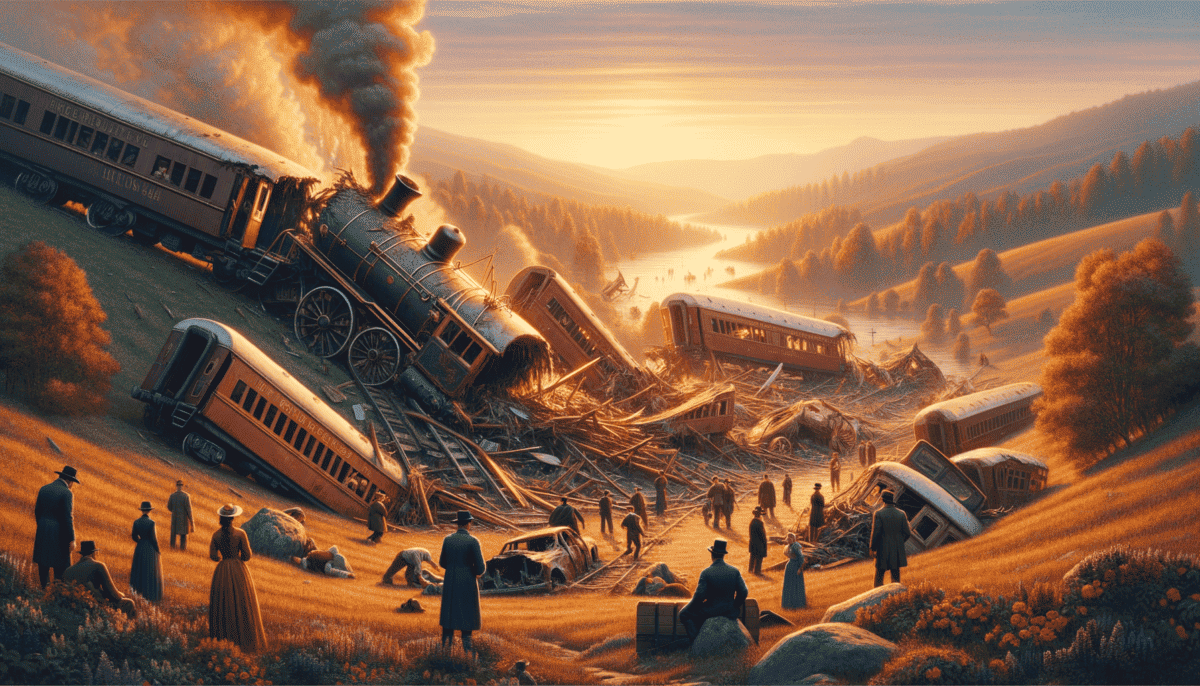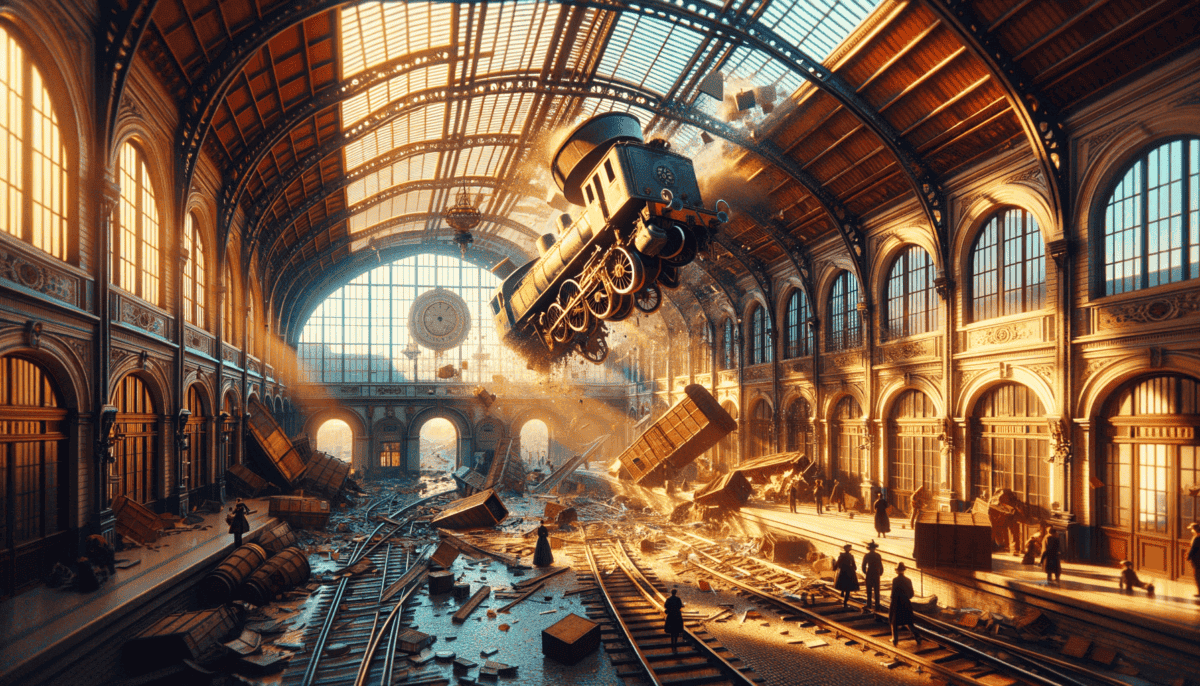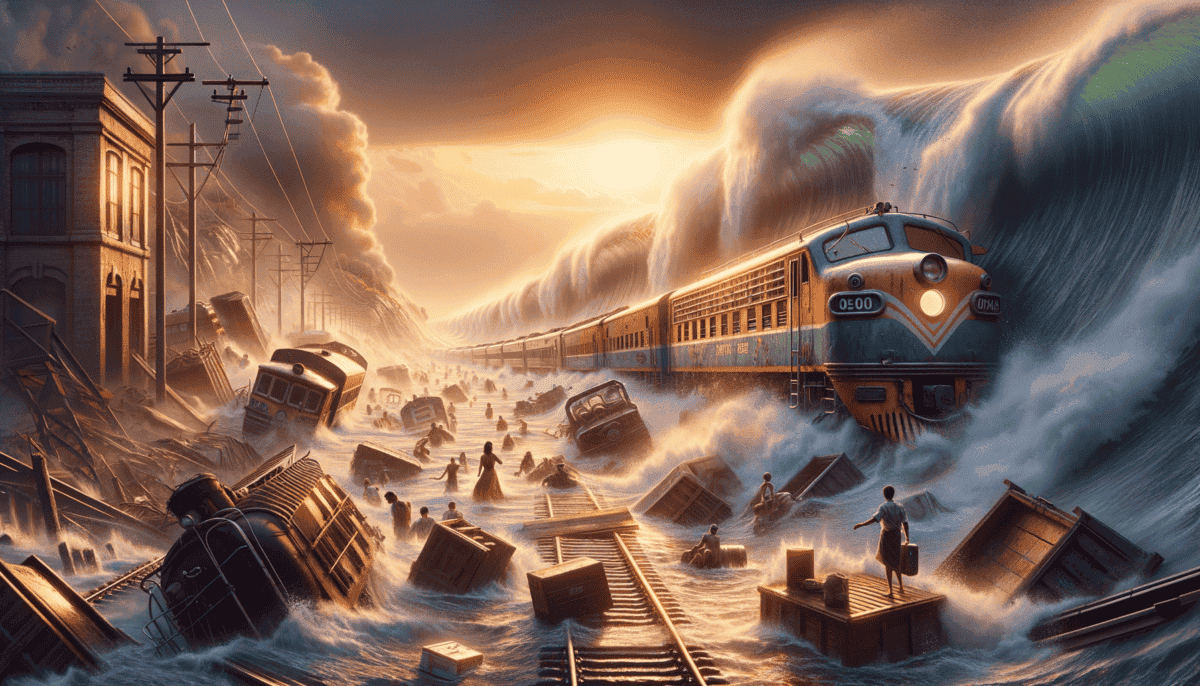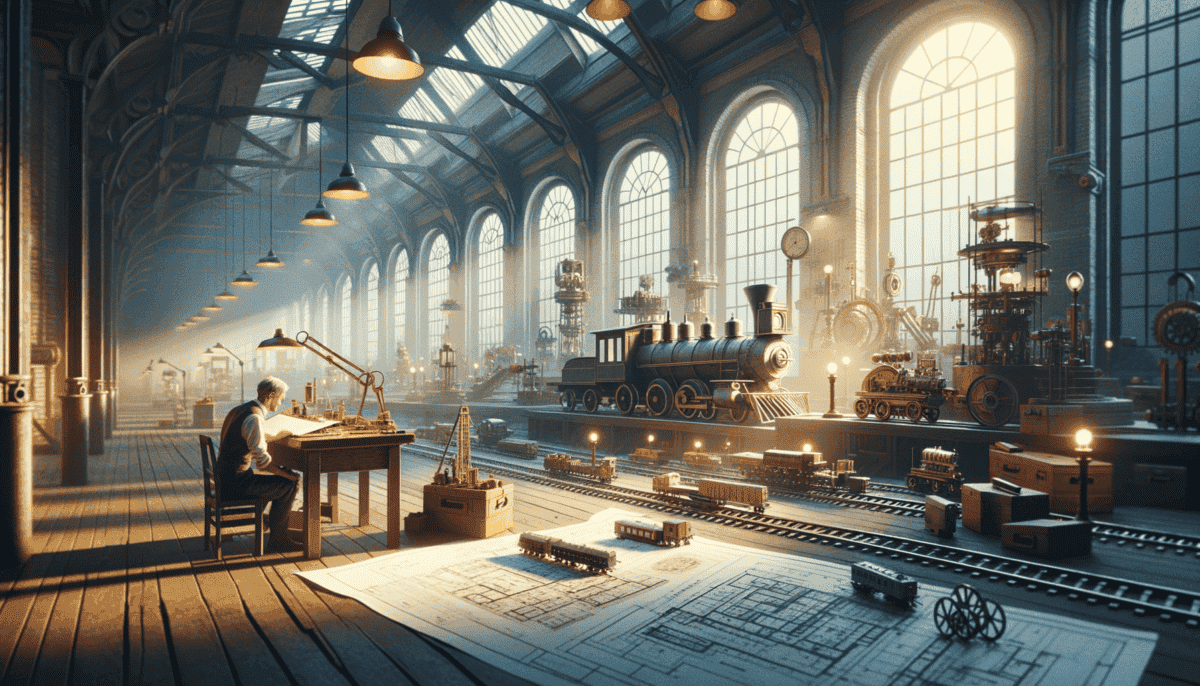The Dawn of Railways
The year was 1825. A shiny new train chugged down the tracks in England. People had never seen anything like it! The big steam engine puffed white clouds into the sky as it moved faster than any horse could run.
The train was like a giant metal caterpillar, crawling along steel rails. Its wheels went clickety-clack as smoke billowed from its tall chimney. This was the start of something amazing – the age of railways had begun!
A New Way to Travel
Before trains, people had to ride horses or walk everywhere. It could take weeks to go from one city to another! But trains changed everything. They could carry lots of people and move really fast.
“These steam engines will change the world,” said George Stephenson, who built some of the first trains. “They’ll bring people together like never before!”
The first trains weren’t very safe though. Sometimes they went too fast and jumped off the tracks! The drivers had to learn how to control these powerful machines. It was like learning to ride a bike, but much harder!
Building the Iron Roads
Thousands of workers laid down train tracks across the land. They used big hammers to pound steel rails into place. It was hard work, but they were building something special.
But there were problems too. Sometimes the tracks weren’t built right. Other times, trains couldn’t stop fast enough. People had to learn new rules to stay safe around these metal giants.
Steam Power Magic
The best part of these early trains was their steam engines. They worked like giant tea kettles on wheels! Here’s how they worked:
- Coal fire heats water in a big tank
- Water turns to steam
- Steam pushes pistons
- Pistons make wheels turn
- Train moves forward!
Engineers wore special uniforms with shiny buttons. They had to be very careful. One wrong move could cause big trouble! But when everything worked right, it was like magic. ✨
Growing Pains
As more trains started running, new problems came up. Different train companies used different kinds of tracks. Some trains were too big for bridges. Others went too fast around curves.
Train Talk:
Driver: “She’s running smooth today!”
Fireman: “Keep her steady now, these curves are tricky!”
Driver: “Don’t worry, I know what I’m doing!”
People started asking important questions: How do we make trains safer? What happens when two trains need the same track? Who decides which train goes first?
Train companies had to make new rules. They put up signals to tell trains when to stop or go. They made schedules so trains wouldn’t crash into each other. But sometimes things still went wrong…
A New World
Even with all the problems, trains were amazing. They carried food to hungry cities. They brought families together. They helped people explore new places. The age of railways was just beginning, and nobody knew what exciting – or scary – things would happen next.
The sun set over the railway yard. Steam hissed from cooling engines. Tomorrow would bring new adventures on the iron rails. But that’s another story…
A Day of Thunder and Steel
The morning of July 17, 1856, started like any other in Camp Hill, Pennsylvania. The sun was bright and warm. Birds sang in the trees. But this day would soon become very different.
The big train was full of happy people. Many were children from St. Michael’s Church. They were going on a picnic! Everyone was excited and laughing.
The Warning Signs
But something wasn’t right. Another train was coming the other way. It was carrying lots of heavy stuff. The tracks weren’t supposed to have two trains at once!
“Something’s wrong,” whispered Tommy Baker, a young boy looking out the window. “I can feel the tracks shaking funny.”
The train drivers couldn’t see each other. There were too many trees and hills in the way. They didn’t know they were heading for the same track!
The Crash
BOOM! The two trains hit each other hard. It sounded like thunder! Metal crashed and bent. Windows broke. People screamed.
Brave people from nearby farms ran to help. They brought water and blankets. They helped people get out of the broken trains. Everyone worked together to save lives.
Heroes of the Day
Here are some of the brave helpers:
- Farmer John Miller, who used his wagon as an ambulance
- Mary Thompson, who gave water to hurt people
- Doctor Samuel Smith, who helped the injured
- Local kids who ran to get more help
- Train workers who saved passengers
A Helper’s Words:
Mary: “We must help everyone we can!”
John: “Get more blankets from my house!”
Doctor: “Stay calm, help is here!”
Learning from Mistakes
After the crash, people knew things had to change. Train companies made new rules:
✅ Better signals to warn trains
✅ Special people to watch the tracks
✅ New ways to tell time the same way
✅ Better brakes on trains
Never Forgotten
Today, there’s a special place in Camp Hill to remember what happened. It has flowers and a stone with words about the crash. People still leave flowers there.
Changes for the Better
The Great Train Wreck of 1856 made trains safer for everyone. People learned from what went wrong. They worked hard to make sure it wouldn’t happen again.
New inventions came along. Better ways to talk between trains. Stronger tracks and bridges. Smarter rules for drivers. Each change made trains a little safer.
The sun set on Camp Hill that evening. The broken trains were gone. But the story of that day lives on, teaching us to be careful and look out for each other. The night was quiet, but somewhere else, another train whistle blew…
The Day the Train Climbed the Wall
The streets of Paris were busy that October morning in 1895. People hurried past the big Montparnasse train station. Nobody knew they were about to see something amazing!
Engineer Guillaume was worried. His train was behind schedule. He made the train go faster and faster.
A Speedy Mistake
The big steam engine raced toward the station. It was going too fast! The brakes weren’t working right. People on the platform started to point and shout.
“Look out!” yelled Marie, a flower seller. “The train isn’t slowing down!”
CRASH! The train didn’t stop at the end of the track. It went right through the station wall! The front of the train stuck out of the building like a giant metal nose.
A Lucky Escape
Something amazing happened. Nobody died in the crash! One person got a small hurt – a lady who was walking outside when pieces fell. She sold newspapers on the street.
Kids pointed and grown-ups took pictures. It looked like something from a silly story!
The Clean-Up Crew
Getting the train down was hard work. Here’s what they needed:
- Big cranes to lift the train
- Strong ropes and pulleys
- Lots of brave workers
- Smart engineers to make plans
- Patient police to keep people safe
What People Said:
Little Boy: “Mama, the train thinks it’s a bird!”
Old Lady: “I’ve never seen anything like it!”
Worker: “This will take forever to fix!”
Making Trains Safer
After this funny-looking crash, train companies made new rules:
✅ Better brakes on all trains
✅ Speed limits in stations
✅ Special stops at track ends
✅ More training for drivers
A Famous Picture
The crashed train became very famous! People still look at pictures of it today. It shows up in books and movies. Some artists even made paintings of it!
The Station Today
Montparnasse station is still there in Paris. It looks very different now. But some old people still tell stories about the day a train tried to fly! The station has super strong walls now, just in case.
Sometimes when trains pull into the station, kids ask their parents, “Will this train climb the wall too?” The parents just smile and say no. Today’s trains are much safer!
As night fell over Paris, the lights of the station twinkled. Trains came and went safely. But the story of the flying train lived on, making people laugh and think about being careful. Far away, another train whistle echoed in the dark…
Wave of Destruction
The sun rose bright over Sri Lanka on December 26, 2004. The Queen of the Sea train was ready for its journey. No one knew this would be a day they’d never forget.
A Happy Morning Turns Scary
The train was full of happy people. Some were going to see family. Others were on holiday. Little kids pressed their faces against windows to see the ocean.
“Look how pretty the sea is today!” said Maya, a little girl sitting with her mom.
But something strange was happening. The ocean was acting weird. It started moving away from the shore, like someone had pulled a giant plug!
The Big Wave Comes
Suddenly, people started screaming. A huge wall of water was racing toward the train! It was taller than houses!
The train conductor tried to help. He told everyone to stay inside the train. He thought the heavy train would be safe.
Heroes Help Others
Some brave people did amazing things:
- Local fishermen used their boats to save people
- Kids helped other kids climb to high places
- Train workers helped passengers get to roofs
- Villagers brought food and blankets
- Doctors came from far away to help
What Survivors Remember:
Young Boy: “The water came so fast!”
Old Man: “Everyone tried to help each other.”
Train Worker: “We didn’t give up hope.”
The World Helps
When other countries heard what happened, they sent help:
✈️ Doctors and nurses
Medicine and food
Materials to build houses
Lots of caring people
Making Trains Safer from Nature
Remembering and Learning
Today, there’s a special place to remember what happened. People come to learn about train safety and nature’s power. They also learn about helping others when bad things happen.
Little Maya, now grown up, still visits the memorial. She tells her own kids about that day. She teaches them about being brave and helping others.
As the sun set over the ocean that evening, trains still ran along the coast. But now they had better ways to stay safe. The sound of waves mixed with train whistles, telling a story of sadness, bravery, and hope. In another part of the world, people were working on even more ways to make trains safer…
Safety Solutions
The morning sunlight sparkled on shiny new train tracks. Sarah the Safety Engineer smiled as she watched workers install a special sensor. It would help keep trains from having accidents. ️
Smart Trains Get Safer
All around the world, people like Sarah were making trains safer. They learned from past accidents to build better trains. It was like giving trains special powers! ♀️
“Remember when trains used to crash because they couldn’t talk to each other?” Sarah asked her team. “Now they can send messages just like we send text messages!”
Cool New Safety Tools
Here are some amazing things that help keep trains safe now:
- Magic Eyes that see through fog and rain
- Smart Brakes that stop trains super fast
- Special Track Checkers that find broken rails
- Weather Watchers that warn about storms
- Computer Helpers that keep trains on schedule
Heroes Who Made Trains Better
Meet some special people who helped make trains safer:
Train Safety Heroes:
Tommy: Made better brakes
Maria: Created smart signals
Jack: Built stronger tracks ️
Learning from Mistakes
Every time something went wrong with a train, people worked hard to fix it. They were like doctors making sick trains better! ⚕️
Testing New Ideas
Before new safety tools could help real trains, they had to pass lots of tests. It was like giving trains a check-up at the doctor!
Scientists used special rooms called labs to try new ideas. They made tiny model trains to practice with. Sometimes things didn’t work the first time, but they never gave up!
Working Together
Sarah loved seeing how people worked together. Train drivers told engineers about problems. Engineers made new tools. Workers installed the tools. Everyone helped!
Safety Never Stops
As the sun set, Sarah looked at her notebook. Tomorrow would bring new ideas for making trains even safer. Maybe someday, there would be no more train accidents at all!
The evening train whistled as it passed by, carrying happy passengers home. Thanks to people like Sarah and her team, everyone could ride trains with big smiles. And somewhere else, more amazing train adventures were about to begin…
A Safer Tomorrow
The rising sun painted the sky orange as Sarah walked into the new Train Safety Center. Today was special – they were showing kids how modern trains stay safe!
Amazing New Trains
The children gasped as they saw the shiny control room. Bright screens showed trains moving all over the country. It looked like a video game, but it was real!
“Look!” shouted little Tommy. “That train just talked to another train!”
Sarah nodded proudly. “That’s right! Our trains are like smart phones on wheels now. They can talk to each other and avoid problems!”
The Future is Here
The children watched as Sarah showed them special cameras that check tracks for tiny cracks. Computers that predict when parts need fixing. And robots that help keep everything running smoothly!
Everyone Helps
Sarah introduced the kids to her team:
Carlos: Fixes smart signals
Lisa: Programs safety computers
James: Checks track sensors ️
Safety Adventures
The children got to play with a train simulator. It was like a giant video game that taught them about train safety!
Dreams Come True
As the tour ended, little Emma tugged on Sarah’s sleeve. “I want to be like you when I grow up! I want to make trains safer too!”
Sarah smiled. She remembered being a little girl who loved trains. Now she helped protect millions of passengers every day.
Looking Forward
That evening, Sarah watched the sunset from her office. Trains glided smoothly along the tracks below, carrying people safely to their families.
“We’ve come so far,” she thought, “but there’s still so much more we can do!”
On her desk sat drawings from the children – pictures of future trains with wings, underwater tracks, and rainbow safety lights. Sarah pinned them to her wall. Maybe some of these dreams would come true too!
As stars began twinkling in the sky, Sarah knew that somewhere, a new generation of train safety heroes was growing up. They would make trains even better, faster, and safer than anyone could imagine.
The story of train safety wasn’t ending – it was just beginning a brand new chapter. And thanks to people who cared, who worked hard, and who never stopped trying to make things better, everyone could look forward to amazing train adventures ahead!






